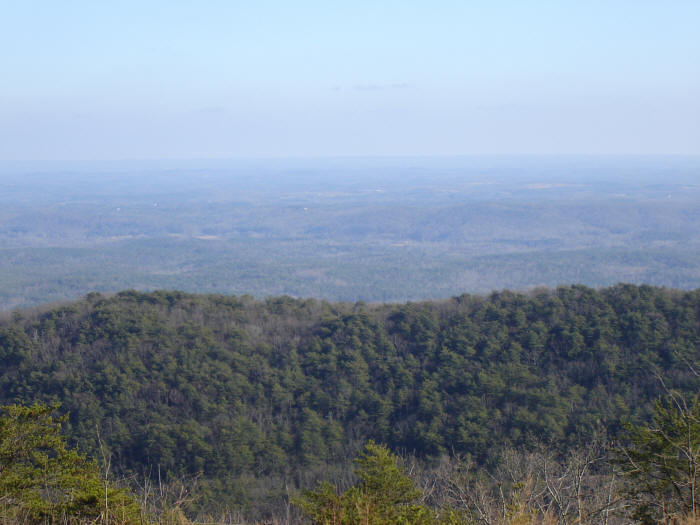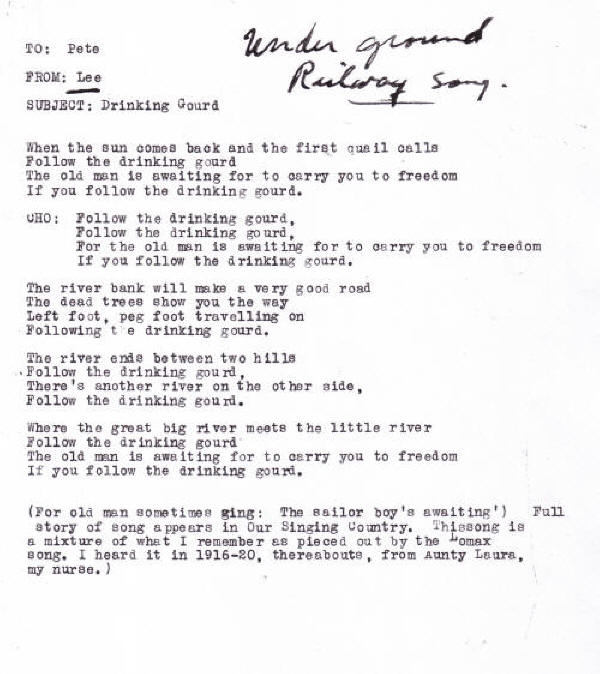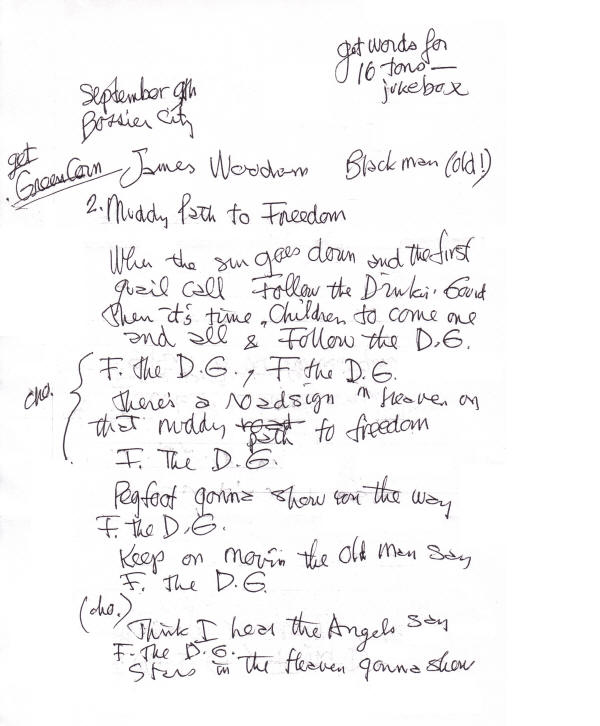What the Lyrics Mean
The following explanations are drawn principally from the H.B. Parks
article, supplemented by my own research.
H.B. Parks Version
|
LYRICS |
EXPLANATION |
|
VERSE 1 |
Taken together, this verse suggests escaping in the spring and
heading North to freedom. |
| When the sun come back,
|
Refers to the winter or spring. The days are getting longer, and
the angle of the sun is higher each day at noon. |
| When the firs' quail call, |
Refers to the breeding season. Quail in Alabama start calling to
each other in early to mid-April. |
| Then the time is come |
|
| Foller the drinkin' gou'd. |
The "drinkin' gou'd" alludes to the hollowed out gourd used by
slaves (and other rural Americans) as a water dipper. Used here it is a code name for the Big Dipper star
formation, which points to Polaris, the Pole Star, and North.
|
|
CHORUS |
|
| Foller the drinkin' gou'd, |
|
| Foller the drinkin' gou'd; |
|
| For the ole man say, |
"Ole man" is nautical slang for "Captain" (or "Commanding
Officer.") According to Parks, the Underground Railroad
operative Peg Leg Joe was formerly a sailor. |
| "Foller the drinkin' gou'd." |
|
|
VERSE 2 |
Describes how to follow the route, from Mobile, Alabama north.
|
| The riva's bank am a very good road, |
The first river in the song is the Tombigbee, which empties into
Mobile Bay. Its headwaters extend into northeastern Mississippi.
|
| The dead trees show the way, |
According to Parks, Peg Leg Joe marked trees and other landmarks
"with
charcoal or mud of the outline of a human left foot and a
round spot in place of the right foot."
(1) |
| Lef' foot, peg foot goin' on, |
| Foller the drinkin' gou'd. |
|
|
CHORUS |
|
|
VERSE 3 |
Describes the route through northeastern Mississippi and into
Tennessee. |
| The riva ends a-tween two hills,
|
The headwaters of the Tombigbee River end near Woodall Mountain,
the high point in Mississippi and an ideal reference point for a
map song. The "two hills" could mean Woodall Mountain and a
neighboring lower hill. But the mountain itself evidently has a
twin cone profile and so could represent both hills at once. |
| Foller the drinkin' gou'd;
|
|
| 'Nuther riva on the other side
|
The river on the other side of the hills is the Tennessee, which
extends outward in an arc above Woodall Mountain. The left-hand
side proceeds virtually due north to the Ohio river border with
Illinois – definitely the preferred route, since the right hand
side meanders back into northern Alabama and then proceeds up
into Tennessee. |
| Follers the drinkin' gou'd. |
|
|
CHORUS |
|
|
VERSE 4 |
Describes the end of the route, in Paducah, Kentucky. |
| Wha the little riva
|
When the Tennessee... |
| Meet the grea' big un,
|
...meets the Ohio River. The Tennessee and Ohio rivers come
together in Paducah, KY, opposite southern Illinois. |
| The ole man waits-- |
Per one of Parks's informants, the runaways would be met on the
banks of the Ohio by the old sailor. Of course, the chances that
Peg Leg Joe himself would be there to meet every escapee (as
depicted literally in the children's books) are quite small. |
| Foller the drinkin' gou'd. |
|
(Stand-alone lyrics
here.)

View from the top of Woodall Mountain. (Source)
Parks also reports hearing a different chorus in Waller Texas in
1918:
|
ALTERNATE LYRICS |
EXPLANATION |
Foller the Risen Lawd,
Foller the Risen Lawd;
The bes' thing the Wise Man say,
"Foller the Risen Lawd." |
Parks believed the Drinking Gourd lyrics came first, and
the Risen Lord lyrics followed. Lee Hays believed that
Risen Lord was a revivalist hymn and that it came first,
followed in turn by the Drinking Gourd song. (See the
Hays version, immediately below.) |
Lee Hays Arrangement
| LYRICS |
EXPLANATION |
| VERSE 1 |
Taken together, this
verse suggests escaping in the spring and heading North to
freedom. |
| When the sun
comes back, |
Refers to the winter or
spring. The days are getting longer, and the angle of the sun is
higher each day at noon. |
| and the first
quail calls, |
Refers to the breeding
season. Quail in Alabama start calling to each other in early to
mid-April. |
| Follow the
drinking gourd |
The "drinking gourd"
alludes to the hollowed out gourd used by slaves (and other
rural Americans) as a water dipper. Used here it is a
code name for the Big Dipper star formation, which points to
Polaris, the Pole Star, and North. |
| The old man
is awaiting for to carry you to freedom |
"Ole man" is nautical
slang for "Captain" (or "Commanding Officer.") According to
Parks, the Underground Railroad operative Peg Leg Joe was
formerly a sailor. Per one of Parks's informants, the runaways
would be met on the banks of the Ohio by the old sailor. Of
course, the chances that Peg Leg Joe himself would be there to
meet every escapee (as depicted literally in the children's
books) are quite small. |
| If you follow
the drinking gourd.
|
|
| CHORUS |
|
| Follow the
drinking gourd, |
|
| Follow the
drinking gourd, |
|
| For the old
man is awaiting for to carry you to freedom |
|
| If you follow
the drinking gourd. |
|
| VERSE 2 |
Describes how to follow
the route, from Mobile, Alabama north. |
| The river
bank will make a mighty good road |
The first river in the
song is the Tombigbee, which empties into Mobile Bay. Its
headwaters extend into northeastern Mississippi. |
| The dead
trees show you the way |
According to
Parks, Peg Leg Joe marked trees and other landmarks "with
charcoal or mud of the outline of a human left foot and a
round spot in place of the right foot."
(1) |
| Left foot,
peg foot, traveling on |
| Follow the
drinking gourd. |
|
| CHORUS |
|
| VERSE 3 |
Describes the route
through northeastern Mississippi and into Tennessee. |
| The river
ends between two hills,
|
The headwaters of the
Tombigbee River end near Woodall Mountain, the high point in
Mississippi and an ideal reference point for a map song. The
"two hills" could mean Woodall Mountain and a neighboring lower
hill. But the mountain itself evidently has a twin cone profile
and so could represent both hills at once. |
| Follow the
drinking gourd, |
|
| There's
another river on the other side, |
The river on the other
side of the hills is the Tennessee, which extends outward in an
arc above Woodall Mountain. The left-hand side proceeds
virtually due north to the Ohio river border with Illinois –
definitely the preferred route, since the right hand side
meanders back into northern Alabama and then proceeds up into
Tennessee. |
| Follow the
drinking gourd. |
|
| CHORUS |
|
| VERSE 4 |
Describes the end of the
route, in Paducah, Kentucky. |
| Where the
great big river meets the little river |
When the Ohio River meets
the Tennessee. The Tennessee and Ohio rivers come together in
Paducah, KY, opposite southern Illinois. Note that the order of
the rivers has been switched, most likely for poetic reasons. |
| Follow the
drinking gourd |
|
| The old man
is awaiting for to carry you to freedom |
|
| If you follow
the drinking gourd. |
|
(Stand-alone lyrics
here.)

Undated memo from Lee Hays
to Pete Seeger in Lee Hays's papers at the Smithsonian.
Hays
notes, "This song is a mixture of what I remember as pieced out by the
Lomax song. I heard it in 1916-1920, thereabouts, from Aunty Laura, my
nurse."
John Woodum Version
| LYRICS |
EXPLANATION |
| VERSE 1 |
|
| When the sun
goes down |
Vs. "Sun comes back" in
the original, which indicates time of year. |
| And the first
quail call |
In the original, refers
to the breeding season. With the word change in line one, this
lyric cannot have the same meaning. |
| Follow the
drinkin' gourd |
The "drinking gourd"
alludes to the hollowed out gourd used by slaves (and other
rural Americans) as a water dipper. Used here it is a
code name for the Big Dipper star formation, which points to
Polaris, the Pole Star, and North. |
| Then it's
time, children |
|
| to come one
and all and |
|
| Follow the
drinkin' gourd |
|
| CHORUS |
|
| Follow the
drinkin' gourd, |
|
| Follow the
drinkin' gourd |
|
| There's a
roadsign in heaven |
|
| On that muddy
path to freedom |
|
| Follow the
drinkin' gourd |
|
| VERSE 2 |
|
| Pegfoot gonna
show you the way |
According to Parks, the
one-legged Peg Leg Joe was an Underground Railroad operative who
marked trees and other landmarks "with
charcoal or mud of the outline of a human left foot and a
round spot in place of the right foot."
(1) |
| Follow the
drinkin' gourd |
|
| Keep on movin'
the Old Man say |
"Ole man" is nautical
slang for "Captain" (or "Commanding Officer.") According to
Parks, the Underground Railroad operative Peg Leg Joe was
formerly a sailor. |
| Follow the
drinkin' gourd |
|
| CHORUS |
|
| VERSE 3 |
|
| Think I hear
the angels say |
Another possible
source.
(2) |
| Follow the
drinkin' gourd |
|
| Stars in the
heaven gonna show you the way |
Another possible
source.
(3) |
| Follow the
drinkin' gourd. |
|
| CHORUS |
|
(Stand-alone lyrics
here.)
Woodum's third verse is essentially the same as the beginning of the
first verse of the Randy Sparks arrangement below. Other Woodum phrases
used by Sparks include "muddy path to freedom" and "keep on movin'".


Randy Sparks's field notes from Bossier City (across
the Red River from Shreveport, Louisiana) dated September 9th (1955.) Reprinted with
permission.
Randy Sparks Arrangement
| LYRICS |
EXPLANATION |
| CHORUS 1 |
|
| Follow the drinkin' gourd, we gonna |
"Follow the Drinking Gourd" is from the Woodum
original. The "drinking gourd" alludes to the hollowed out gourd
used by slaves (and other rural Americans) as a water dipper.
Used here it is a code name for the Big Dipper star
formation, which points to Polaris, the Pole Star, and North. |
| Follow the drinkin' gourd. |
|
| Oo-oo-oo-waa, |
|
| Follow the drinkin' gourd |
|
| VERSE 1 |
|
| Think I heard the angels say, |
From the Woodum original. See another possible
source
here. |
| Follow the drinkin' gourd. |
|
| Stars in the heaven gonna show you
the way, |
From the Woodum original. See another possible
source
here. |
| Follow the drinkin' gourd. |
|
| |
|
| Step by step keep a'travelin' on |
|
| Follow the drinkin' gourd. |
|
| Sleep in the holler 'til the
daylight is gone, |
|
| Follow the drinkin' gourd |
|
| CHORUS 2 |
|
| Follow the drinkin' gourd, we gonna |
|
| Follow the drinkin' gourd. |
|
| Keep on travelin' that muddy road
to freedom, |
The original read, "muddy path to freedom." |
| Follow the drinkin' gourd. |
|
| VERSE 2 |
|
| There's a good day comin' and it
won't be long, |
|
| Follow the drinkin' gourd. |
|
| All God's children gotta sing this
song, |
|
| Follow the drinkin' gourd. |
|
| |
|
| Follow that river 'til the clouds
roll by, |
|
| Follow the drinkin' gourd. |
|
| Keep on movin' better look to the
sky, |
"Keep on movin'" is from the original. |
| Follow the drinkin' gourd. |
|
| CHORUS 3 |
|
| Follow the drinkin' gourd, we gonna |
|
| Follow the drinkin' gourd. |
|
| There's a little bit of heaven in
that muddy road to freedom, |
The original read, "muddy path to freedom." |
| Follow the drinkin' gourd. |
|
| Step by step keep a'travelin' on, |
|
| Follow the drinkin' gourd. |
|
(Stand-alone lyrics
here.)
Randy Sparks wrote me, "my thinking on (omitting) 'the first quail
call' lyric likely had to do with the fact that this sounded like an
error to me. It still does. I'm into birds, heavily, and the first quail
calls in the morning, not after dark. My experience has been that
they're damned quiet after the sun goes down, as they don't want to give
away their roosting location. That line made no sense to me."
(Sparks is correct about quail behavior, see
note. The Woodum
lyrics diverge here from the Parks version.) He was
also trying to avoid much overlap with the Weavers' lyrics, "Another
reason for staying away from it, I would say, likely had to do with not
wanting to include any material from the Weavers' recording, which I had
heard by the time we approached the song."
|